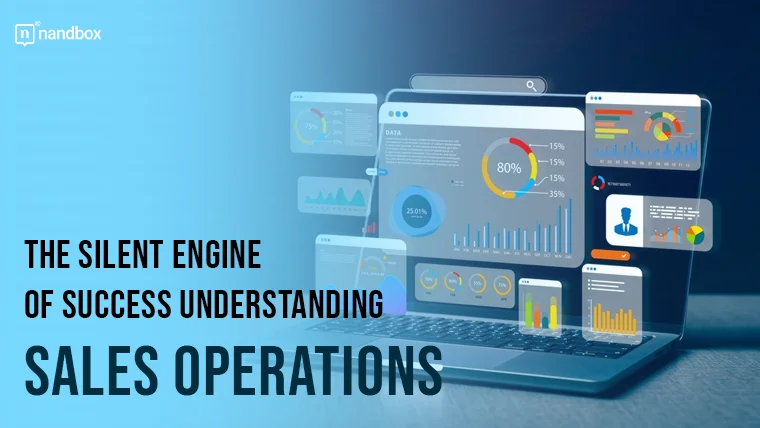Behind every successful sales team is an effective sales operations (SalesOps) function driving strategic frameworks, productivity optimizations, and critical analysis, empowering revenue growth. However, SalesOps often operates “behind the scenes” with less visibility despite the immense value of influencing sales outcomes.
What is Sales Operations?
Sales operations refer to the combination of strategies, processes, tools, analysis, and support structuring the systems enabling sales teams to prosper. Like an engine powering performance, SalesOps introduces frameworks that maximize sales productivity.
These activities typically include:
- Data Analysis and Reporting: Monitoring metrics influencing sales force effectiveness to uncover optimization opportunities. Presenting insights through dashboards and models and visualizing team progress.
- Process Optimization: Mapping and improving lead management, pipeline tracking, forecasting, and other sales training workflows central to productivity.
- Technology Implementation and Management: Selecting, customizing, and overseeing essential sales technologies like CRM platforms supporting efficient processes.
- Sales Enablement: Creating playbooks, offering collateral, onboarding programs, and continued training advancing sales rep skills, knowledge, and readiness for engaging buyers.
- Sales Forecasting and Planning: Leveraging historical performance data and trends for modeling and predicting future sales results by region, customer segment, or product line. Informs strategic planning.
Think of SalesOps as the operational backbone, reinforcing sales teams to excel.
Why Sales Operations Matters
With so many moving parts influencing sales cycles from lead generation to closing deals, SalesOps coordination is essential for growth, and working with a strategy mentor can help refine processes, align teams, and maximize sales performance.
Here’s why sales operations consulting professionals are essential for your company’s success:
- Improved Sales Productivity: Optimizing processes, adopting sales acceleration technologies, and refining strategy boost rep efficiency, securing more deals faster.
- Data-Driven Decision Making: Analytics on lead sources, pipeline trends, and region performance. grounds decisions in factory analysis rather than guesswork intuition. By integrating sales intelligence tools, teams can extract deeper insights to inform their strategies.
- Increased Sales Effectiveness: Sales enablement and ongoing training enhance skill sets, translating into improved lead follow-up and higher sales conversions.
- Enhanced Sales Forecasting: Accurate forecasting aligns inventory planning, informs hiring needs according to projections, and assists financial budgeting across the company.
- Cost Reduction: Analytics often uncover unnecessary systems bloat or excess spending reallocation towards proven sales drivers, increasing ROI.
Key Sales Operations Functions
Sales operations encompass a wide range of functions, each playing a crucial role in driving sales success:
Sales Strategy Development
Crafting overarching sales plans supporting business objectives requires evaluating markets, buyers, channels, and resource allocation for go-to-market entry and expansion. This involves:
- Market Analysis: Research market size, growth factors, competition benchmarks, customer segments, and sales potential for informing strategic decisions.
- Sales Channel Optimization: Deciding ideal sales models based on product complexity, customer locations, and segment preferences—whether direct sales reps, channel partners, or online e-commerce. Using tools like CRM for sales reps can help streamline these processes and improve efficiency.
- Pricing Strategy: Setting product and service rates aligned to costs and customer-perceived value while remaining competitive.
- Sales Incentive Programs: Structuring motivational commissions, contests, and bonus structures incentivizing reps to meet goals.
Sales Process Optimization
Regularly examining and upgrading lead management systems, account targeting, pipeline reviews, and technology platforms enhances procedural efficiency. This involves:
- Lead Management: Defining and training standardized lead qualification and nurturing processes, improving handoffs between marketing and sales.
- Pipeline Management: Install pipeline review rhythms and dashboards monitoring deal progress over set stages to accelerate opportunities and increase forecast reliability.
- Sales Activity Tracking: Capture essential sales activities within CRM for extracting insights on what actions influence winning deals.
- Sales Process Automation: Eliminate repetitive manual tasks like outreach and follow-ups via software such as Expandi or Expandi alternatives to accelerate productivity.
Sales Analytics and Reporting
Centralized analytics and insightful reporting fuel data-informed decision-making at every sales level. This involves:
- Key Performance Indicator (KPI) Tracking: Establish quantifiable metrics on lead response rates, sales cycle length, and contract values. revealing operational efficiency.
- Sales Dashboard Creation: Visualize essential KPIs, trends, and deal statuses through centralized dashboards, flagging risks and opportunities.
- Sales Forecasting: Leverage statistical modeling and projections anticipating future revenue by lead source, region, or product line.
- Sales Performance Analysis: Compare rep-level metrics like calls made, opportunities closed, and contract values, determining coaching needs, skill gaps, and star players.
Sales Technology Management
SalesOps is responsible for selecting, implementing, and maintaining the technology tools that the sales team uses. This involves:
- CRM Implementation and Customization: Map software capabilities to in-house processes, workflows, and reporting needs via system configuration. Oversee adoption and change management.
- Sales Intelligence Tools: Install platforms aggregating useful triggers on target accounts, informing rep interactions and campaign targeting.
- Sales Communication Tools: Arm reps with email sequence software, auto-dialers, and video chat solutions excelling in outreach.
- Sales Automation Tools: Adopt AI-assisted tools to qualify inbound leads, personalize emails, and speed documentation creation.
Sales Enablement
SalesOps provides training, resources, and support to the sales team, empowering them to succeed. This involves leveraging sales enablement software to streamline and enhance these processes:
- Sales Training Programs: Structure onboarding curriculum and facilitate ongoing workshops elevating selling skills.
- Sales Playbooks: Standardize proven discovery questions, common objection handling, competitive differentiators, and closing best practices for reps by documenting and distributing playbooks.
- Sales Content Development: Produce targeted email templates, brochures, sample call decks, and micro-campaign assets that help reps pitch deals.
- Sales Coaching and Mentoring: Schedule one-on-one coaching for new hires, conduct skills assessments identifying staff needing specialized guidance, and foster mentor/mentee relationships.
Sales Compensation and Incentive Programs
SalesOps designs and manages sales compensation and incentive programs that motivate sales reps to achieve their goals. This involves:
- Commission Structures: Balance market pay standards, margins, and rewards for hitting targets without overpaying underperformers.
- Sales Contests: Gamification through leaderboard contests, raffles, and recognition ceremonies further drives competition, closing incremental deals.
- Sales Recognition Programs: Celebrate outstanding reps for closing renewals, winning new business, and cross-selling success through awards, glitzy trips, or choice leads.
Territory Management
SalesOps designs and manages sales territories to ensure that each salesperson has a fair and equitable opportunity to achieve their goals. This involves:
- Territory Alignment: Group customers and prospects into geographic or account clusters, assigning balanced revenue opportunities to reps.
- Quota Setting: Configure equitable quotas or assign numerical sales objectives by territory, considering unique regional market factors and history.
- Territory Performance Analysis: Calculate revenue production, activity rates, and pipeline creation by territory, determining laggards, developing hot spots, and consolidation needs.
- Territory Optimization: Keep territories aligned optimally to evolving market conditions with updates like adding underserved adjacent geographies or reconfiguring resources away from declining areas.
Best Practices in Sales Operations
For maximum SalesOps impact, leading organizations focus on:
- Aligning Sales and Marketing through orchestrated lead definition, nurturing, hand-off, and closed-loop reporting confirming downstream ROI.
- Utilizing Advanced Analytics like machine learning and predictive modeling beyond conventional dashboards extracts deeper insights from data.
- Continuous Process Improvement through the iteration of systems, protocols, and skills training prevents stagnation even amid success.
- Implementing Robust CRM Systems centralizing a “single source of truth” for prospect and customer data, interactions, and transactions manages complexity at the enterprise scale.
- Fostering a Collaborative Culture builds bridges between SalesOps leadership, operations, and sales professionals of all levels and supports departments in improving idea flows.
Conclusion
World-class SalesOps separate good sales teams from the best through aligned frameworks, productivity enhancements, and actionable analytics capabilities. Now you grasp all core components, from key functions to best practices involved in architecting the sales engine propelling your company forward. While individual sales professionals deserve immense credit for interfacing with prospects and ultimately closing business, the SalesOps machinery empowering their effectiveness works wonders behind the scenes, scaling success.





